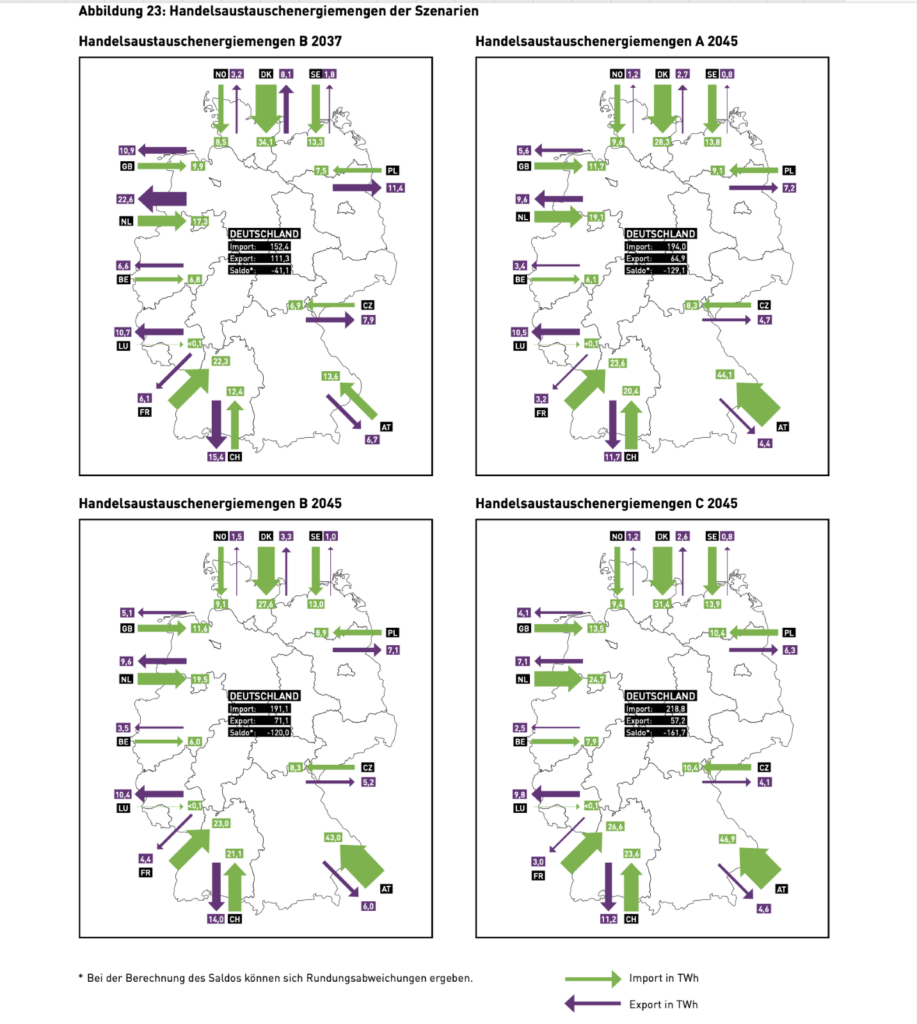Wer die Sozialen Medien der letzten Zeit verfolgt hat, der könnte glauben, dass der Atomausstieg Deutschland tatsächlich zur Disposition steht. Das ist natürlich nicht der Fall. Umso erstaunlicher, dass die ARD eine relativ ausgewogene Dokumentation zum Thema Ausstieg sendet. Diese Dokumentation kommt allerdings zu spät. Sie ist nur noch ein Abgesang. Da nutzen auch keine Interviews mit Grünen in Finnland, Politikern in Frankreich oder Aktivisten im Vereinigten Königreich. Kein großes Industrieland folgt Deutschland auf seinem Weg. Das zeigt die Dokumentation eindeutig auf. Experten aus dem Ausland schütteln eher den Kopf über den deutschen Weg. Vielleicht ja auch deshalb, weil sie ahnen oder sogar wissen, dass Deutschland das Ausland in Zukunft dringend braucht.
Wenn man sich den Netzentwicklungsplan ansieht, den die großen Netzbetreiber aufgestellt haben, dann kann man schon sehr ins Grübeln kommen. Deutschland drückt seinen Nachbarn offenbar ganz fest die Daumen in Zukunft genügend Strom zu produzieren und diesen nach Deutschland zu exportieren. Der Plan sieht verschiedene Szenarien vor und egal, welches man nimmt, Deutschland wird Stromimporte benötigen in der Zukunft. Auf Seite 68 des Berichts der Netzbetreiber wird es spannend.

(Abbildung: Screenshot Netzentwicklungsplan)
Aus dem einstigen Stromexport-Land Deutschland wird ein Importeur im Jahr 2045. Die Frage ist lediglich, wie hoch der Anteil der Importe ist. Er schwankt in den Szenarien. Vor allem Österreich wird offenbar viel zugetraut bei der Belieferung mit Strom 2045. Spannend ist auch, dass in den verschiedenen Szenarien von erheblichen Größen bei der Abschaltung ausgegangen wird, was letztlich bedeutet, einige Verbraucher keinen Strom haben werden im Jahre 2045, jedenfalls nicht zuverlässig.
“Abschaltbare Lasten werden im Szenario C 2045 mit etwas über 1.000 h/a am häufigsten eingesetzt. Der Stromverbrauch und das entsprechende Preisniveau sind in diesem Szenario am höchsten. In den Szenarien A und B sind die Volllaststunden im Bereich von 680 bis 750 h / a für abschaltbare Lasten auf ähnlichem Niveau. Bei den verschiebbaren Lasten sind nur geringfügige Unterschiede zwischen den Szenarien erkennbar. Die Volllaststunden bewegen sich im Bereich von 730 bis 850 h / a.”
Es würde sicherlich zu weit führen jeden Aspekt des TV-Berichts zu thematisieren. Aber dennoch scheint es erhebliche Unterschiede in den Berechnungen der Netzbetreiber und den Prognosen einiger Experten zu geben. Warum auch immer die eine rosige Zukunft zeichnen, die Szenarien derjenigen, die sehr wahrscheinlich auch in 20 Jahren noch die Netze betreiben werden, sehen etwas anderes vor. Vielleicht gibt es ja doch Unterschiede zwischen der täglichen Arbeit und dem Sitzen im Elfenbeinturm, ausgerüstet mit einem Fernglas und vermeintlich schlaue Prognosen aus der Ferne aufstellend.
So eine Prognose stellt Patrick Graichen auf. Der Staatssekretär im Wirtschaftsministerium wird in der Dokumentation natürlich auch interviewt. Er hat das Wort Kohle aus seinem Wortschatz gestrichen als er in dem TV-Beitrag von der Stromversorgung der Zukunft sprach. Dabei wird die Kohle noch einige Jahre eine wichtige Rolle bei der deutschen Stromproduktion spielen. Problemlösung durch aktive Verdrängung.
Für Auftritte in den Medien mögen Wünsche reichen, nur verlassen sollte man sich auf die Aussagen besser nicht. Die von Graichen erwähnten Gaskraftwerke, die später mal mit Wasserstoff laufen sollen, gibt es in dieser Form noch gar nicht. Und Wasserstoff ist wertvoll, da er sehr teuer in der Produktion ist, wenn man dazu Strom einsetzt. Vielleicht weiß Graichen das als Experte nicht?!
Wie verletzlich das Ego einiger Experten ist, kann man übrigens sehr schön an dem Begriff “Champagner” sehen. Der Spiegel-Journalist Claus Hecking hatte ihn in Bezug auf die Energiewende benutzt und wurde von der omnipräsenten Kemfert bei Twitter auf diesen kapitalen Fehler hingewiesen. Vielleicht sah sie hier eine Copyright-Verletzung?
Zumindestens ist es aber eine grobe Majestätsbeleidigung, Kemfert nicht als Zitatgeberin erwähnt zu haben. Das musste Kemfert auf Twitter erst einmal klarstellen. Wahrscheinlich weiß Claudia Kemfert nicht, dass Champagner nicht wegen der Herstellungskosten seinen hohen Preis hat, sondern weil es ein ausgeklügeltes Marketing mit künstlicher Verknappung ist. Die Anbauflächen in der französischen Champagne sind begrenzt und die Hersteller haben dem Schaumwein schon sehr früh das Luxuslabel verpasst. Die Knappheit und die Nachfrage bestimmen den Preis, nicht aber die Produktionskosten. Wer Schaumwein mag, wird sehr guten für deutlich weniger Geld kaufen können.
Wasserstoff ist aber nicht aus Marketinggründen knapp und teuer. Er ist ganz besonders teuer, wenn er mit Strom aus Deutschland hergestellt wird, ganz einfach, weil der Strom zur Produktion hier sehr teuer ist. Kann man als Wirtschaftswissenschaftlerin wissen, muss man aber auch nicht.
Dann kann man gern bei dem eigentlich falschen Begriff bleiben. Oder man kann wie Graichen fest daran glauben, dass teuer hergestellter Wasserstoff später einmal zu günstigem Strom wird.

(Abbildung: Screenshot Twitter)
+++
Oceanic Heat Content as a Predictor of the Indian Ocean Dipole
Indian Ocean Dipole (IOD) prediction is a challenging problem, largely relying on the relationship between IOD and El Niño-Southern Oscillation (ENSO). This study demonstrates that heat content internal to the Indian Ocean can be an effective predictor providing extra IOD predictability, through constructing statistical prediction models with and without heat content as a predictor. Two recently proposed heat content predictors, equatorial heat content (EQHC) and heat content in the eastern pole of the Dipole (SEHC) are compared in this study. Results show that EQHC is more effective partly because it is relatively independent of ENSO and partly because it does not rely on IOD persistence, as does SEHC. The efficacy of EQHC as an IOD predictor is seasonally dependent, being most effective at 5–8-month lead times beginning in the preceding late boreal winter and spring.
Key Points:
- Heat content internal to the Indian Ocean provides IOD predictability in addition to El Niño-Southern Oscillation, especially at 5–8-month lead times
- Heat content as a predictor is seasonally dependent, being most effective as an initial condition in the boreal winter and spring
- Equatorial heat content is more useful than heat content in the eastern pole of the Dipole as a predictor when accounting for persistence
Plain Language Summary:
The Indian Ocean Dipole (IOD), a major climate mode in the tropical Indian Ocean, can lead to severe floods and droughts over surrounding continental areas. Prediction of the IOD is very challenging due to the apparent lack of effective predictors besides the El Niño-Southern Oscillation. This study compares two recently proposed predictors for the IOD based on upper ocean heat content, one along the equator and one in the southeastern tropical Indian Ocean. Equatorial heat content proves to be more effective, especially for predictions starting in the late boreal winter and spring. This study helps to improve our understanding of IOD dynamics and its predictability.
+++
Skillful Decadal Flood Prediction
Abstract
Accurate long-term flood predictions are increasingly needed for flood risk management in a changing climate, but are hindered by the underestimation of climate variability by climate models. Here, we drive a statistical flood model with a large ensemble of dynamical CMIP5-6 predictions of precipitation and temperature. Predictions of UK winter flooding (95th streamflow percentile) have low skill when using the raw 676-member ensemble averaged over lead times of 2–5 years from the initialization date. Sub-selecting 20 ensemble members that adequately represent the multiyear temporal variability in the North Atlantic Oscillation (NAO) significantly improves the flood predictions. Applying this method we show positive skill in 46% of stations compared to 26% using the raw ensemble, primarily in regions most strongly influenced by the NAO. Our findings reveal the potential of decadal predictions to inform flood risk management at long lead times.
Key Points
- Multiyear predictions of mean winter floods 2–5 years ahead are skillful across much of the UK
- Skill is improved by “NAO-matching” to overcome spuriously weak modeled signals
- The higher the sensitivity of streamflow to the North Atlantic Oscillation at a given gauge, the greater the benefit of NAO-matching for decadal flood prediction
Plain Language Summary
Reliable predictions of flooding can help society to manage the associated risk to lives and property. Seasonal predictions of flooding over the coming months already form the basis of many operational services around the world. In contrast, decadal predictions with lead times of up to 10 years are more challenging, due to the difficulty of simulating dynamic changes in atmospheric circulation at these timescales. Here, we show that a large ensemble of climate models can predict average winter flood conditions over the UK in the next decade. The climate models underestimate the magnitude of atmospheric variability in the north Atlantic and identifying a subset of skillful climate model simulations improves the ability to predict floods. Our results suggest that decadal climate predictions may be useful in the context of flood risk management. However, the use of multiyear averages for flood prediction is still poorly studied, and therefore further work should help determine how such predictions can be used in an operational setting.
+++
ENSO–IOD Inter-Basin Connection Is Controlled by the Atlantic Multidecadal Oscillation
Abstract
The interactions between El Niño-Southern Oscillation (ENSO) and Indian Ocean Dipole (IOD) are known to have great implications for global climate variability and seasonal climate predictions. Observational analysis suggests that the ENSO–IOD inter-basin connection is time-varying and related to the Atlantic Multidecadal Oscillation (AMO) with weakened ENSO–IOD relationship corresponding to AMO warm phases. A suite of Atlantic pacemaker simulations successfully reproduces the decadal fluctuations in ENSO–IOD relationship and its link to the AMO. The warm sea surface temperature (SST) anomalies associated with the AMO drive a series of Indo-Pacific mean climate changes through tropical-wide teleconnections, including the La Niña-like mean SST cooling over the central Pacific and the deepening of mean thermocline depth in the eastern Indian Ocean. By modulating ocean–atmosphere feedback strength, those mean state changes decrease both ENSO amplitude and the Indian Ocean sensitivity to ENSO forcing, therefore decoupling the IOD from ENSO.
Key Points
- The inter-basin connection between El Niño-Southern Oscillation (ENSO) and Indian Ocean Dipole is time-varying and controlled by the remote Atlantic Multidecadal Oscillation (AMO)
- The AMO sea surface temperature anomalies drive a series of Indo-Pacific mean climate changes through tropical-wide teleconnections
- The AMO induced mean state changes influence both ENSO amplitude and the Indian Ocean sensitivity to ENSO forcing
Plain Language Summary
The El Niño-Southern Oscillation (ENSO) and Indian Ocean Dipole (IOD) are two most important interannual climate signals exciting world-wide climate and socioeconomic impacts. Their interactions are known to have great implications for global climate variability and seasonal climate predictions. However, the ENSO–IOD relationship is time-varying and show prominent decadal fluctuations. Such changes in ENSO–IOD relationship are associated with the decadal variation in IOD teleconnections and predictability. The prediction skill of IOD is high when the ENSO–IOD relationship is strong, and vice versa. But it remains unknown what controls the decadal modulation of Indo-Pacific inter-basin connection. Our findings suggest that the Atlantic Multidecadal Oscillation (AMO) may modulate the ENSO–IOD inter-basin connection. The AMO sea surface temperature anomalies drive a series of Indo-Pacific mean climate changes through tropical-wide teleconnections. Those mean state changes further influence both ENSO amplitude and the Indian Ocean sensitivity to ENSO forcing, thereby modulating the ENSO–IOD relationship. This study advances our understandings on inter-basin and cross-scale interactions in the climate system.
